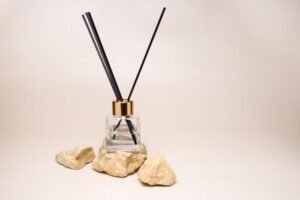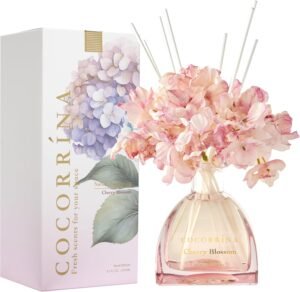Ever walked into a home that instantly made you feel welcome with its delightful aroma? The secret to creating that inviting atmosphere lies in choosing the right scenting method for your space.
Home scenting options range from reed diffusers and essential oil diffusers to room sprays, candles, and even perfume. Each method offers different benefits in terms of longevity, intensity, and maintenance requirements to suit various living situations and preferences.
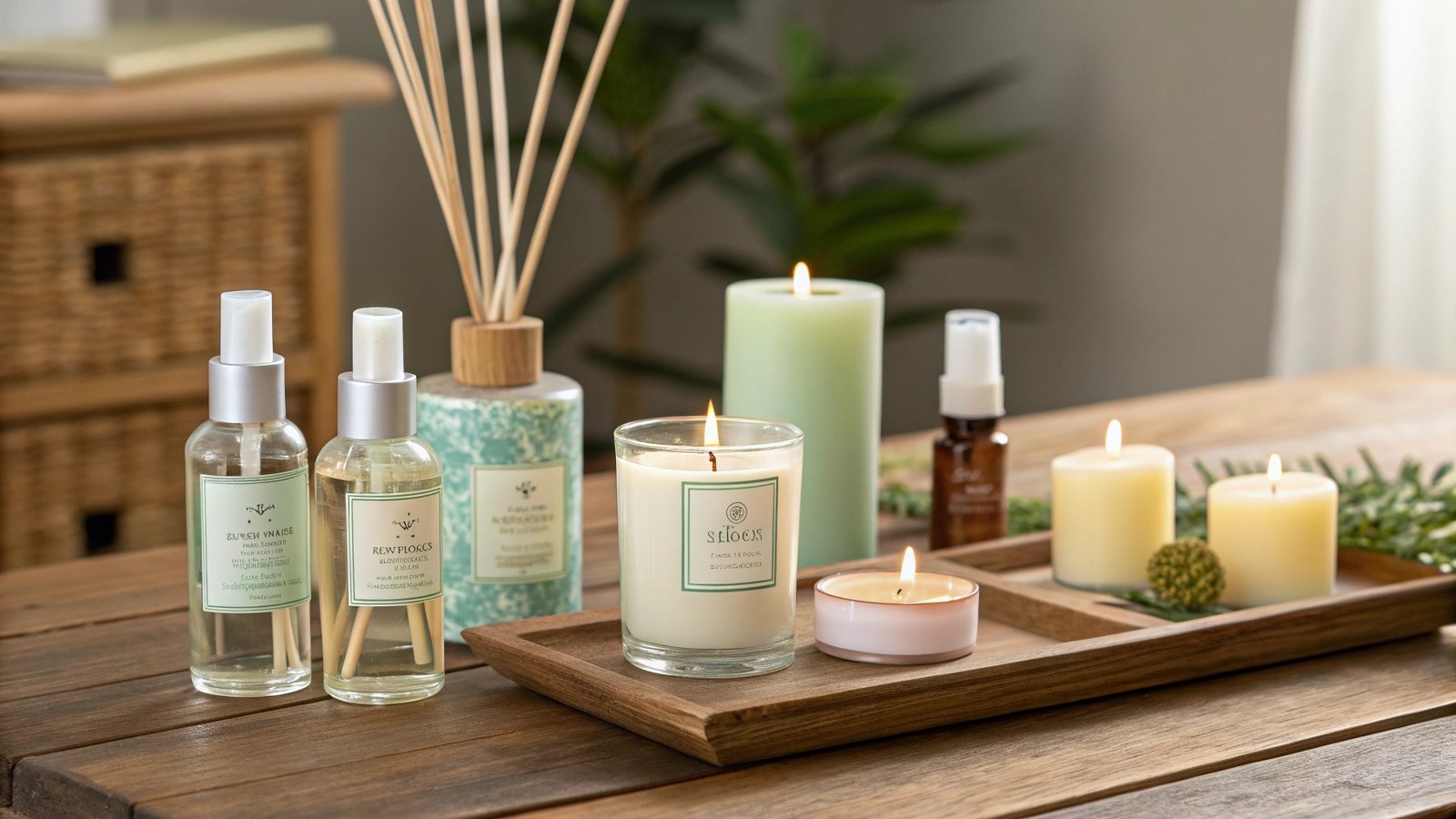
Let’s explore the different ways to fragrance your home, examining their strengths and weaknesses so you can make the best choice for creating your perfect aromatic environment.
What Are the Most Effective Methods for Scenting Your Home?
Do you find yourself frustrated with home fragrances that fade too quickly or don’t spread evenly throughout your space? The effectiveness of different scenting methods varies significantly in how they disperse aromas.
The most effective home scenting methods include reed diffusers for constant subtle fragrance, essential oil diffusers for controllable intensity, scented candles for ambiance, and room sprays for immediate but temporary freshening.
Comparing Home Scenting Methods
After working with thousands of customers on their home fragrance solutions, I’ve compiled this comprehensive comparison of the main scenting methods:
| Method | Longevity | Intensity | Maintenance | Best For |
|---|---|---|---|---|
| Reed Diffusers | 2-4 months | Low to Medium | Very Low (occasional reed flipping) | Continuous background scenting |
| Essential Oil Diffusers | While operating (hours) | Adjustable | Medium (water refills, cleaning) | Controllable, therapeutic scenting |
| Scented Candles | 30-80 hours | Medium to High | High (lighting, monitoring) | Ambiance and occasional use |
| Room Sprays | 30 minutes-2 hours | High initially, fades quickly | None (just spray as needed) | Quick refreshing |
| Wax Melts | 8-10 hours per melt | Medium to High | Medium (warming, changing) | Stronger scent without flame |
| Potpourri | 2-3 weeks | Low | Low (refreshing with oils) | Decorative scenting |
In my experience supplying products to global markets, I’ve noticed significant regional preferences. European customers often prefer the subtle, maintenance-free approach of reed diffusers, while North American clients frequently select stronger, more immediate options like room sprays and candles.
The effectiveness of any method also depends on your space’s size, airflow, and even humidity levels. A reed diffuser that performs perfectly in a small bathroom might be barely noticeable in an open-concept living area with high ceilings.
Can You Use Perfume to Scent Your Home?
Have you ever considered repurposing that barely-used perfume bottle sitting on your dresser? Using personal fragrances for home scenting is a common question with some important considerations.
While perfume can be used to scent your home by spraying it on unobtrusive surfaces like curtains or lampshades, it’s not ideal due to its alcohol content, high concentration, and formulation designed for skin rather than ambient scenting.
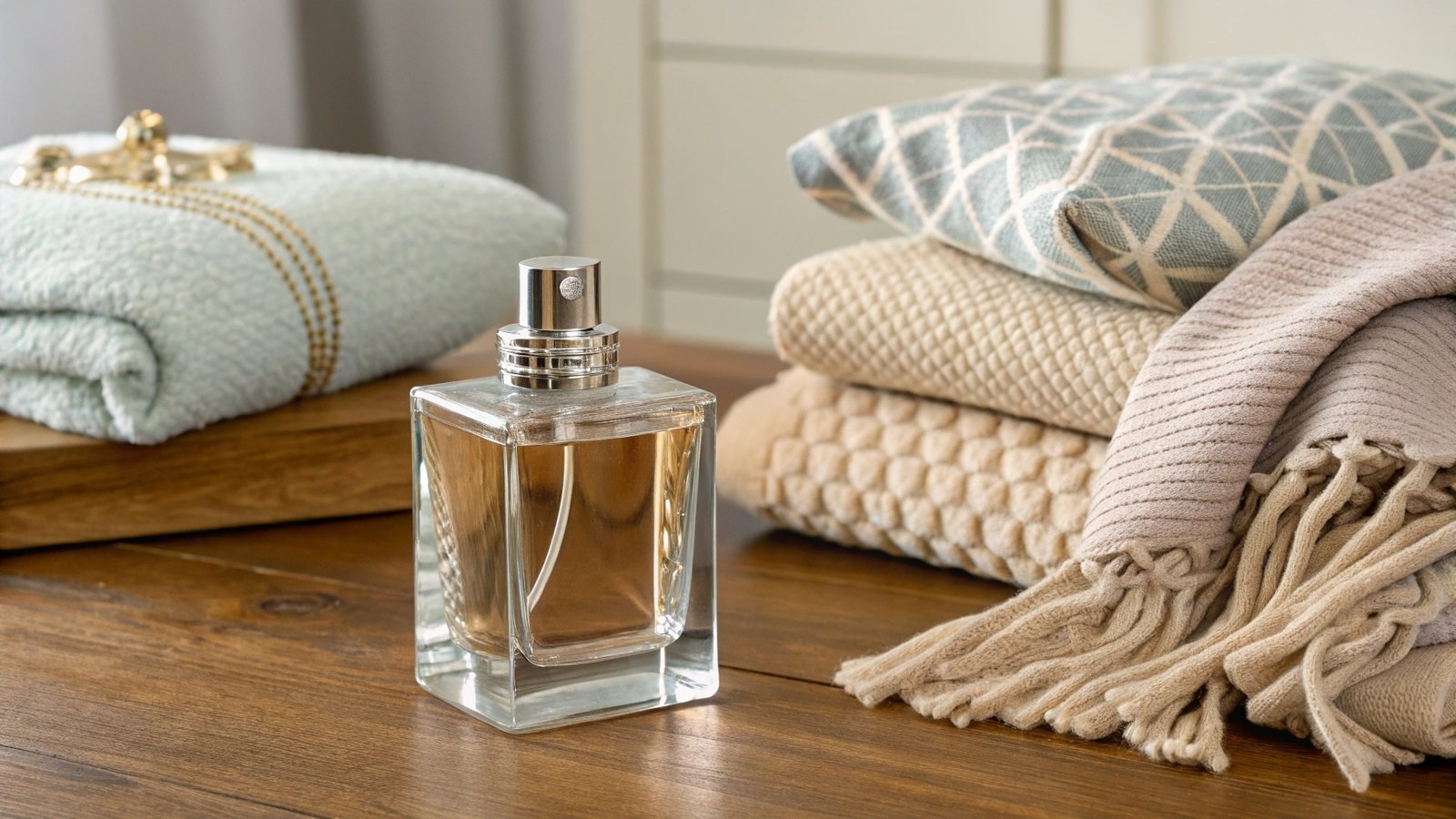
The Pros and Cons of Using Perfume as Home Fragrance
As someone who has formulated both personal and home fragrances, I can tell you that while they may seem similar, they’re designed for different purposes:
| Aspect | Perfume as Home Scent | Dedicated Home Fragrances |
|---|---|---|
| Formula | Contains alcohol that evaporates quickly | Uses slower-evaporating carrier bases |
| Concentration | Very high (can be overwhelming) | Balanced for room dispersion |
| Cost | Expensive per use | More economical for space scenting |
| Scent Profile | Complex, evolving (top/middle/base notes) | More consistent throughout use |
| Staining Risk | Higher (oils can mark fabrics) | Formulated to minimize staining |
| Longevity | Fades quickly in air | Designed for extended ambient presence |
I once had a customer who sprayed her designer perfume throughout her home before guests arrived. While it created an immediate impression, the scent disappeared within an hour and left oil marks on her light-colored sofa—an expensive mistake!
If you’re determined to use perfume for home scenting, consider these safer approaches:
- Apply a drop to unscented wooden diffuser reeds
- Spray onto cotton balls and place in inconspicuous locations
- Apply to the cold light bulb of a lamp (the heat will disperse the scent)
- Add a few drops to your vacuum cleaner filter
However, for both effectiveness and economy, products specifically formulated for home scenting will always deliver better results.
Which Home Scenting Method Lasts the Longest?
Are you tired of constantly replenishing your home fragrance? The longevity of different scenting methods can vary dramatically, affecting both convenience and value.
Reed diffusers typically last longest among home scenting options, providing continuous fragrance for 2-4 months, while essential oil diffusers offer excellent longevity through controlled usage, and quality candles can provide 40-80 hours of ambiance.
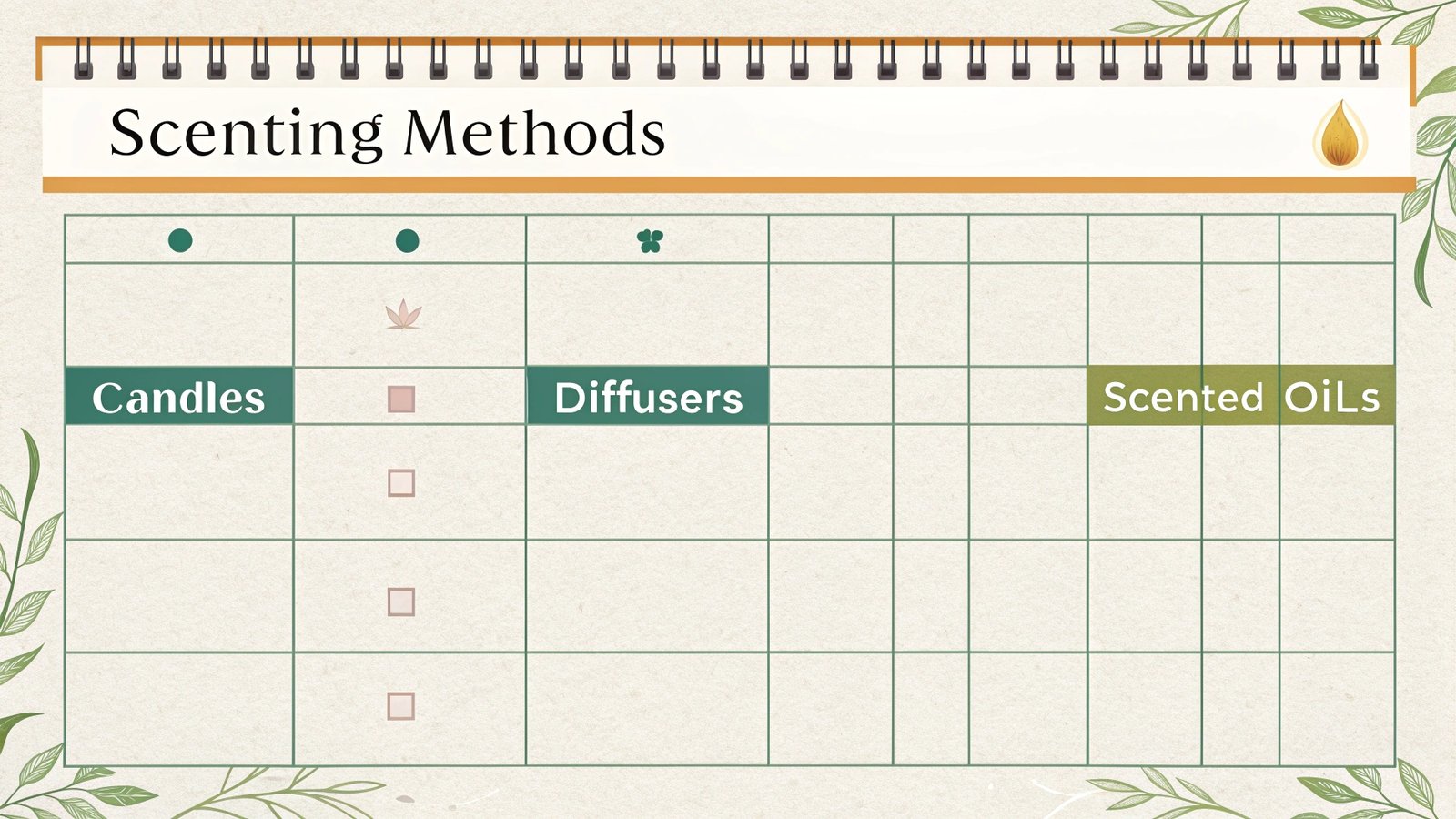
Analyzing Scent Longevity Factors
At ENO, we’ve conducted extensive testing on fragrance longevity across different products and environments. Here’s what we’ve learned about maximizing the staying power of various scenting methods:
| Method | Average Duration | Affecting Factors | Longevity Tips |
|---|---|---|---|
| Reed Diffusers | 2-4 months | Room temperature, air flow, reed count | Use fewer reeds for longer life; choose narrow-necked containers |
| Scented Candles | 30-80 hours | Wax type, fragrance load, burn time | Burn for 2-4 hours per session; trim wick to ¼ inch |
| Essential Oil Diffusers | Refill every 6-8 hours | Diffuser type, oil quality, timer settings | Use intermittent settings; seal oils tightly when storing |
| Potpourri | 2-3 weeks effective scent | Air exposure, oil quality | Refresh with matching essential oils; store in sealed containers |
| Wax Melts | 8-10 hours per cube | Wax type, warmer temperature | Use low temperature settings; cover when not in use |
| Room Sprays | 30 minutes-2 hours | Spray formula, application amount | Layer with complementary scenting methods; spray fabrics not air |
One surprising discovery from our research is that environmental factors significantly impact longevity. The same reed diffuser might last twice as long in a cool, closed room as it would in a warm, ventilated space. Similarly, altitude affects performance—customers in mountain regions often report shorter lifespans for volatile scenting products due to lower atmospheric pressure.
When working with a luxury hotel chain in the Netherlands, we developed a reed diffuser system specifically calibrated to maintain consistent scent intensity throughout its 90-day lifespan. The key innovation was a proprietary base that released fragrance at a more consistent rate, avoiding the common problem of strong initial scent that gradually weakens.
How Can You Layer Different Scenting Methods?
Have you noticed how the most memorably fragranced homes seem to have a signature scent that follows you through different rooms? Professional scenting often employs strategic layering techniques.
Layering scenting methods creates a more complex and lasting aromatic experience, such as using reed diffusers for base notes, occasional candles for mid-notes, and room sprays for top notes, ensuring consistent yet dynamic home fragrance.
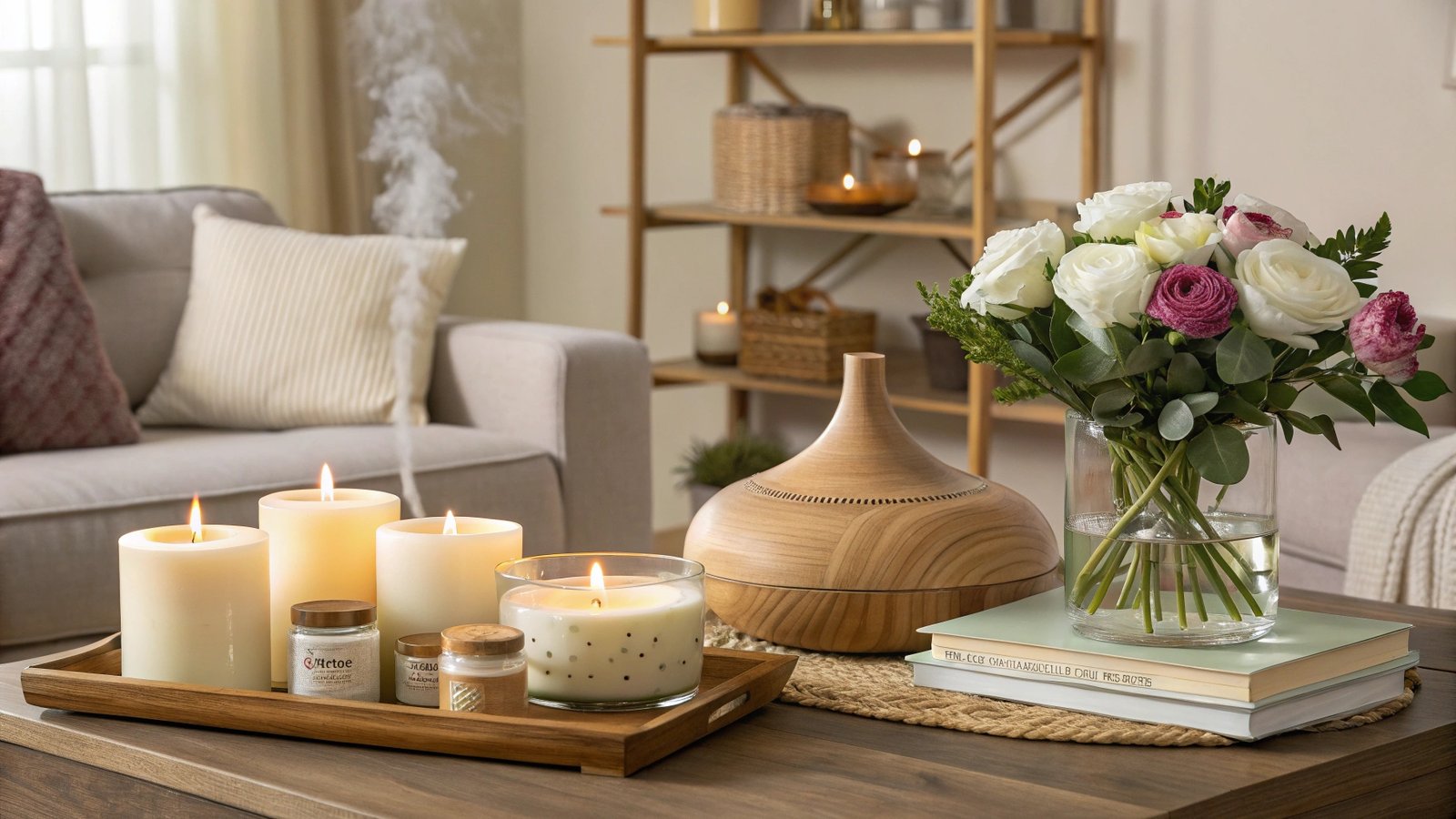
Strategic Approaches to Fragrance Layering
Working with interior designers and hospitality clients has taught me valuable lessons about creating cohesive scent experiences throughout spaces:
| Layering Strategy | Implementation | Benefits |
|---|---|---|
| Scent Anchoring | Place reed diffusers in main living areas | Provides consistent baseline fragrance |
| Occasion Enhancing | Use candles during gatherings | Adds warmth and intensity when needed |
| Zone Scenting | Different complementary scents for different rooms | Creates journey through the home |
| Intensity Control | Combine passive methods with active ones | Adjustable fragrance strength |
| Seasonal Rotation | Change scent families with seasons | Prevents nose blindness, matches ambiance |
The key to successful layering is complementary fragrance families. For example, one successful approach I recommend to clients is:
- Base Layer: Reed diffusers with woody or vanilla notes in main living areas
- Mid Layer: Complementary candles in the same scent family for evenings or gatherings
- Top Layer: Room sprays with fresher notes from the same family for instant refreshing
One of our clients, a boutique bed and breakfast owner, created a signature experience by using lavender reed diffusers throughout common areas, lavender-vanilla candles in the dining room lit during breakfast, and lavender-citrus room sprays that housekeeping used during turndown service. Guests frequently commented that the cohesive yet subtly changing scent profile enhanced their stay.
When layering scents, remember that less is more. Each method should complement rather than compete with the others. Start with fewer products than you think you need—you can always add more intensity, but an overwhelming fragrance combination is difficult to remedy.
Which Home Scenting Methods Are Safest for Pets and Children?
Does concern for your family’s safety make you hesitant about home fragrancing? With varying levels of supervision required and potential hazards, choosing the right scenting method for households with pets or children requires careful consideration.
Reed diffusers and electric diffusers placed out of reach are safest for homes with children and pets, while avoiding essential oils toxic to animals and choosing flame-free options eliminates fire and burn risks.
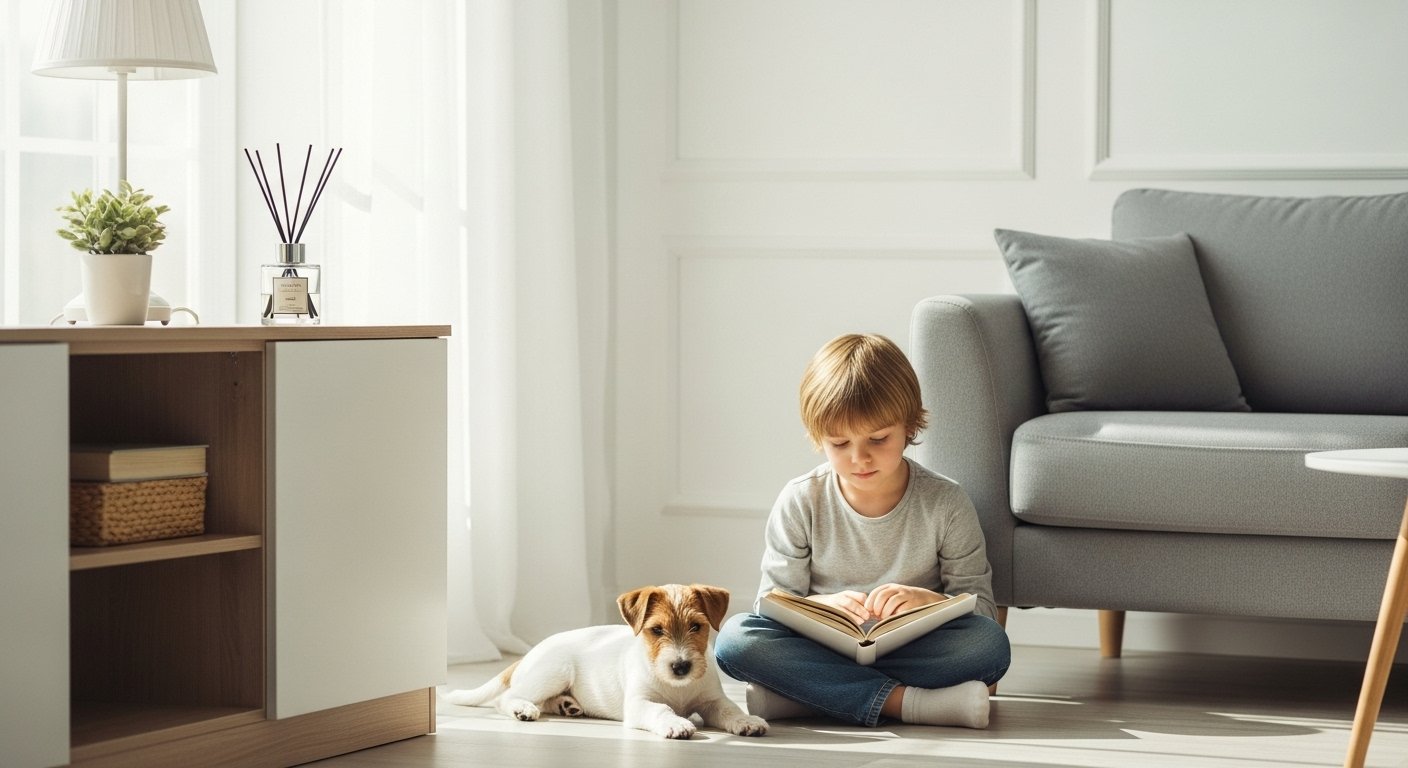
Safety Considerations for Vulnerable Household Members
In my years supplying fragrance products globally, safety concerns from families have consistently influenced purchasing decisions. Here’s a comprehensive safety analysis:
| Method | Safety Concerns | Recommendations |
|---|---|---|
| Reed Diffusers | Spillable liquid; toxic if ingested | Place on high shelves; choose pet-safe formulations |
| Essential Oil Diffusers | Some oils toxic to pets; water spill risk | Use only pet-safe oils; place out of reach |
| Scented Candles | Fire hazard; burn risk; wax spills | Never leave unattended; consider flame-free alternatives |
| Wax Melts | Hot wax; electrical warming units | Use only in supervised areas; cool-touch warmers |
| Room Sprays | Aerosol propellants; overspray | Spray when pets/children absent; avoid direct inhalation |
| Plug-in Air Fresheners | Electrical hazard; accessible height | Choose units with safety covers; use upper outlets |
When formulating our child-safe product line, we eliminated common sensitizing ingredients like lilial and certain musks, even though they’re still permitted in many markets. We also developed specialized reed diffuser bases that are less toxic if accidentally ingested—though they should always be kept out of reach.
For pet owners, it’s critical to know that certain essential oils widely used in home scenting can be toxic to animals, particularly cats who lack certain liver enzymes to process these compounds:
- Avoid for cats: Tea tree, citrus oils, pine, wintergreen, cinnamon, peppermint
- Avoid for dogs: Tea tree, pine, wintergreen, cinnamon (in high concentrations)
- Generally safer options: Lavender (in dilution), chamomile, cedarwood
One innovative solution we’ve developed for safety-conscious homes is our "upper atmosphere" diffusing system that mounts near the ceiling, well out of reach of children and pets while still effectively scenting the space. The diffuser uses larger molecule fragrance compounds that are less likely to cause respiratory sensitivity.
Conclusion
The best home scenting method depends on your specific needs: reed diffusers for maintenance-free continuous fragrance, essential oil diffusers for therapeutic benefits, candles for ambiance, and room sprays for immediate freshness—with safety and longevity guiding your choice.
About Eno
ENO is a leading professional manufacturer dedicated to the research and development of aromatic products. Specializing in scented candles, therapeutic-grade essential oils, reed diffusers, room sprays, and other fragrance solutions, we are committed to delivering high-quality products to meet diverse global needs.
With over 17 years of experience, we export to over 200 countries and regions worldwide. Each year, we supply a large volume of products to North America, Europe, Australia, Japan, South Korea, and Southeast Asia. Our company has established collaborations with globally renowned brands such as MCM, BLUE JACAR, and COZY.
Serving over 1,000 Amazon sellers annually, ENO stands out for its strength in technology, design, and product development. Our team of designers is internationally skilled, bringing ideas from creative design to product research and development, ensuring seamless production. We offer a complete set of solutions, providing products that reflect cutting-edge trends and deliver international competitive value to our clients.


